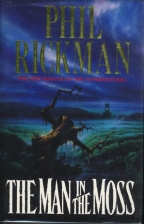The Man in the Moss
Phil Rickman
Pan Books / Macmillan
UK Hardcover
ISBN 0-330-33784-X
Publication Date: 1994
596 pages; £16.99
Date Reviewed: 04-02-1996
Reviewed by Rick Kleffel © 2002

REFERENCES
COLUMNS
|
|
|
The Man in the MossPhil RickmanPan Books / MacmillanUK HardcoverISBN 0-330-33784-XPublication Date: 1994596 pages; £16.99Date Reviewed: 04-02-1996Reviewed by Rick Kleffel © 2002 |
|
|
REFERENCES |
COLUMNS |
Horror writers are often also regional writers. H. P. Lovecraft's famous New England hills were reclaimed 50 years after his death by Stephen King, Dean Koontz stakes his claim in his home territory in Orange County, California, and British writer Ramsey Campbell favors his hometown of Liverpool. Newcomer Phil Rickman has found his own corner of the world, Wales, a prime setting for each of his novels, including his latest, 'The Man in the Moss'. Once a BBC reporter in Wales, Rickman has drawn on his experiences to write a powerfully atmospheric novel of a remote Welsh village whose matriarchal heritage is threatened by the removal of a 'bog man' found in the peat marsh that surrounds it.
The accent -- derfinitely a Welsh accent -- is on the village and its inhabitants. Bridelow is yet another small town with a secret, isolated by the peat bog and famous for its bitter, black beer. Its history is chronicled by its schoolteacher, Ernie Dawber, and the town Matriarch, Ma Wagstaff, keeps the town in harmony with the huge natural powers that surround it. When a 'bog man' is discovered in the moss by workmen building a new road to the brewery, those carefully balanced powers slide out of true, and the easy lives of the villagers are slowly annihilated.
Rickman's strengths lie in his ability to use regional dialect and gorgeous prose to create an atmosphere of bleak menace. He makes the reader care about his characters, and writes a large enough book so that all of them have a chance to come to life within its pages. He eschews the gory violence once popular in the horror genre for the kind of creepy ambience one associates with H. P. Lovecraft and M. R. James. Like most authors who write about rural communities, Rickman compounds the supernatural threats with the incursion of big business and impersonal modern bureacracies, represented here by Gannons, a faceless corporation that buys the Bridelow brewery, then proceeds to put the name on a dark but generic brew out of one of its huge plants, while slowly dismantling the town's only source of employment.
But the heart of Rickman's novel is his portrait of Bridelow's Celtic matriarchal society, based on an ancient intuition of man's connection to the landscape around him. Bridelow is, as it happens, a particularly powerful landscape, and requires a touch not talked about much openly in the town, yet felt and adhered to nonetheless. Rickman captures the 'open secret' of Bridelow well. His characters' shadings and subtlties combined with his descriptive landscapes and well-rendered dialects create a world that is bleak, beautiful and very complex. 'The Man in the Moss' effectively doubles as a classy horror novel and a surreal travelogue through a regional landscape that lingers in the reader's mind like the dense fog hovering over the peat bog.